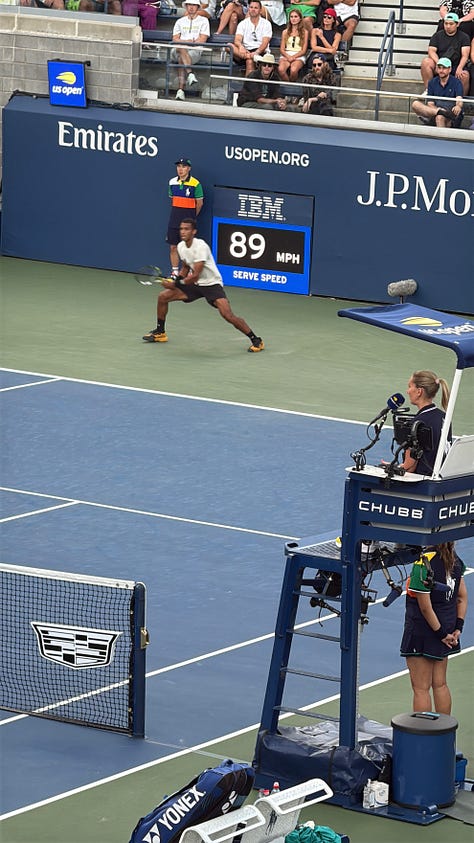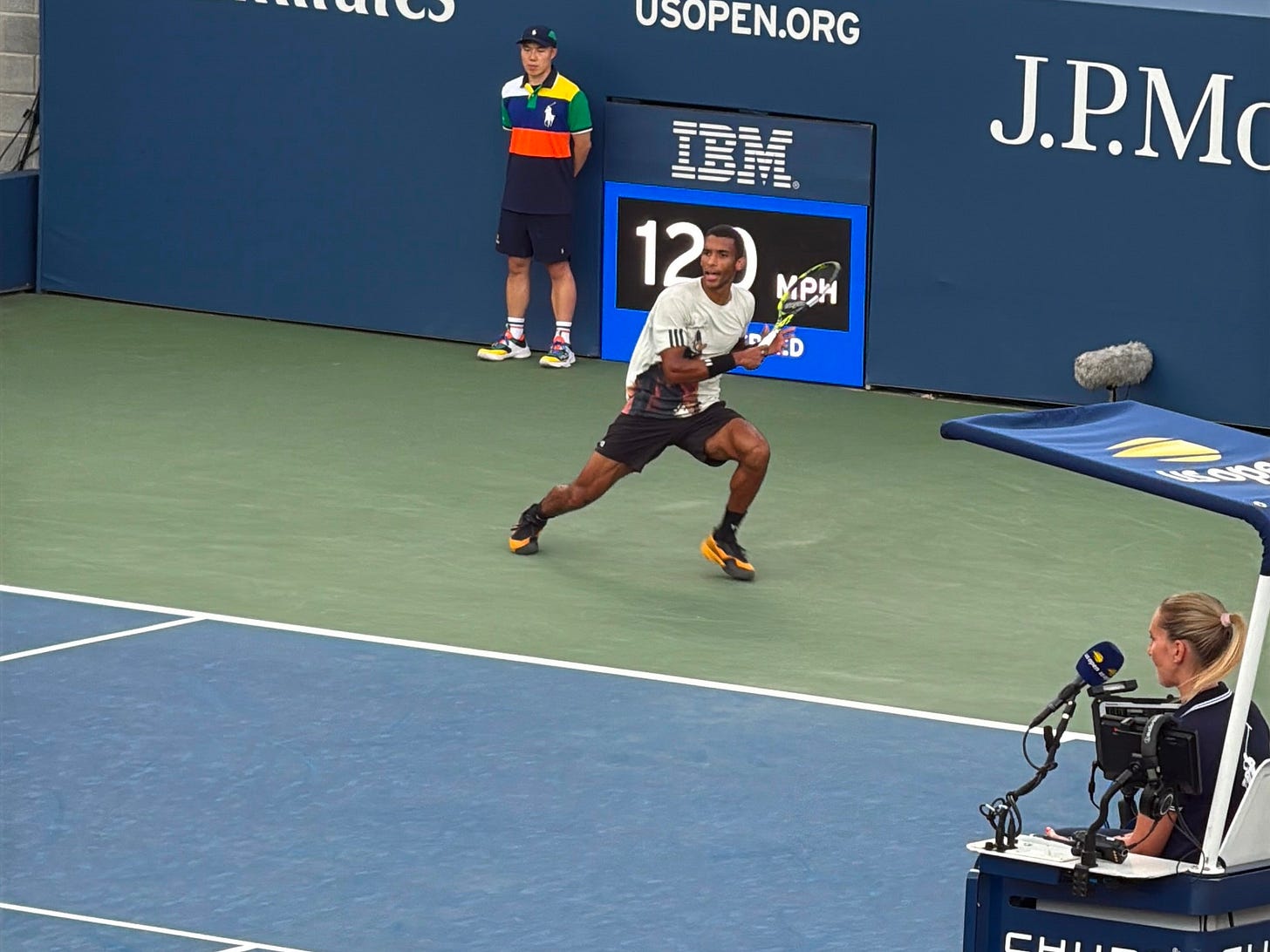The AI grandstand: How IBM’s sports survey signals (motor)sport’s next era
And what I learned from my first US Open.
Thank you for being here. You are receiving this email because you subscribed to Idée Fixe, the newsletter for curious minds. I’m Toni Cowan-Brown, a tech and F1 commentator. I’m a former tech executive who has spent the past five years on the floor of way too many F1, FE, and WEC team garages, learning about the business, politics, and technology of motorsports.
⏳ Reading time: 6min
I was on-site at the US Open last week as a guest of IBM, a partner of the tournament since 1990 - back when the internet barely existed and was mostly a green-on-black terminal screen with minimal system info. Few sponsors can claim this kind of longevity, and fewer still have so thoroughly shaped the way fans consume a sport. From powering the official US Open app to rolling out AI-generated highlights and match insights, and we can’t forget the now-live ‘likelihood to win’ projector. IBM has effectively turned Flushing Meadows into a showcase for the future of fan tech.
I attended IBM’s media night, spoke with several executives shaping the company’s sports strategy, and toured the IBM Data Operations room located directly beneath Arthur Ashe Stadium. Today, I want to dive into the future of AI in sports, explore what’s new in tennis this year, and share what IBM’s latest sports survey reveals about the state of sports fandom.
Notes from my first-ever Grand Slam
The US Open surprised me in so many ways - none more than how enjoyable and relaxing the general admission experience was. It felt like a world apart from motorsports, and in many ways, of course, it is. The range and quality of food and beverages were outstanding, the food court was excellent, and there are even on-site restaurants if you prefer. The sponsor and partner activations were fun, educational, and thoughtfully executed. Importantly, it never felt like sponsors were competing for scraps of attention.
I also hadn’t realised that a grounds pass gives you access to every match and court except Arthur Ashe, which is incredible value for money. When I wasn’t courtside, it felt like spending a leisurely afternoon with friends in Central Park. The people-watching and fashion were the cherry on top. I can absolutely see why fans spend multiple days and evenings here.
A data-driven future for fandom
IBM’s 2025 Sports Survey has a clear message: technology is no longer a side dish in the fan experience, it’s the main course. The report, which polled over 20,000 sports fans worldwide, reveals a fanbase that isn’t just comfortable with AI, apps, and immersive tech, but rather a fanbase that actively expects them, which is surprising for a sport that has its roots in French monastic cloisters in the 12th century.
“The sports media landscape is more complex than ever, and fans are comfortable consuming digital content around the clock,” said Kameryn Stanhouse, Vice President, Sports and Entertainment Partnerships, IBM.
Stanhouse’s point is one I’ve repeated endlessly in Formula 1, especially when it comes to its growing, younger fanbase. These are the new ‘hardcore’ fans - not the ones who sit in silence and watch a race uninterrupted for two hours, but the ones who will consume six-plus hours of F1 content a day through social posts, memes, podcasts, post-race shows, and live events. Being a sports fan today looks very different, and that’s what makes it so exciting. The sports fandoms and our consumption of these sports are constantly shifting.
IBM’s influence now also extends to motorsport as they have recently become a partner of the Scuderia Ferrari F1 team, bringing their data and AI expertise trackside, with a big focus on the fan experience. For motorsports, already defined by data and speed, this isn’t just validation. It’s a clear roadmap.
AI adoption goes mainstream
More than half of sports fans globally are now using generative AI, with 22% using it regularly and 30% occasionally. Adoption is highest in markets like India, the UAE, and Brazil, but is climbing steadily in Europe and North America. The majority of these fans - and players - trust AI-generated content - whether that’s a race recap, predictive analysis, or a personalised highlight package.
The most in-demand AI features are real-time updates (35%), personalised content (30%), unique insights (29%), and predictive analytics (27%). Swap out “player performance” for “pit strategy” or “tyre degradation,” and you see exactly where this maps onto motorsport.
The crossover here is clear. At the US Open, IBM’s AI models serve up instant match insights - forehands, backhands, rally length - translated into fan-friendly stories. In F1, the same logic could apply to live telemetry, pit predictions, and strategy models. AI isn’t just about defence; it’s about anticipation. Just as F1 teams monitor anomalies to avoid disaster, fans are asking AI to enhance their anticipation, predicting the undercut before it happens or surfacing data that tells the deeper story of a race. This allows fans to better understand the sports they love but get more actively involved on race/game day.
This is another natural crossover between tennis and motorsport. Hawk-Eye has revolutionised tennis officiating; fans now trust the tech as much as (if not more than) the human umpire. In F1, Hawk-Eye equivalents already exist - think VAR-style race moment replays, or sensor-driven track limits. The survey suggests fans are open, even eager, for tech to take a bigger role in adjudication and storytelling. The message is the same: fans expect to see more and feel closer through tech.
73% of fans use apps
According to the survey, 73% of global fans use sports apps, jumping to 91% among F1 fans who attend races in person. About 1 in 5 F1 fans (20%) use F1-specific apps, putting the sport on par with tennis and golf. The top reasons for app use: consolidation (all your info in one place), real-time updates when they can’t watch live, and exclusive behind-the-scenes content. What’s fascinating is that this explosion of data isn’t just about volume, it’s about experience
Apps in sport have become the new ‘go-to destination’ for fans and their dual-screen watching habits: the interface where raw data becomes emotional storytelling. Today’s fandom is about multi-device, multi-touchpoint experiences. The Ferrari jacket in the paddock isn’t just a piece of merch - it’s part of a digital identity constructed across apps, streams, and social feeds.
AI + Community = motorsport’s missed opportunity?
One of the most striking shifts in this year’s survey is the rise of community as a priority. Across markets, fans are increasingly ranking “engaging with other fans” and “feeling part of a community” as a top reason for consuming sports content. And AI is being asked to play a role here too: more fans want technology that helps them connect, not just consume. Why not use sports as a way to create community, build friendships and co-create?
Motorsports lags behind here. While stick-and-ball sports lean on fantasy leagues and team-based fandoms, F1’s structure has historically put the teams at the centre, not the community. Tennis, however, offers a model: the US Open app doesn’t just provide stats, it curates fan polls, social integrations, and match-day personalisation. Motorsport could adapt similar AI-powered community tools, bridging official coverage and fan-led conversation.
This links directly to the Professional Fan concept I’ve written about: AI could enable the next wave of fan-led spaces where predictive models, live telemetry, and chat coexist.
Why this matters for F1 & beyond
Data as entertainment: What teams see on the pit wall, fans now want in their pockets in real time, personalised, and explained.
Community as currency: Motorsport has always been about spectacle, but its future growth depends on building shared spaces where fans can engage with each other, not just watch drivers engage with the track. We are already seeing this happen at a grassroots level.
AI as connective tissue: From predictive strategy insights to personalised feeds, AI is becoming the glue between official coverage, creator content, and fan-to-fan interaction.
Emerging markets as test beds: The survey shows tech optimism is highest in regions F1 is targeting for growth. These could become the proving grounds for immersive fan tech.
IBM’s 2025 Sports Survey confirms what many already sense: the future fan doesn’t just want to watch the game, match, or race - they want to experience it, shape it, and share it. That’s why IBM’s dual role as the longest-running tech sponsor of the US Open (since 1990) and now as a partner of Scuderia Ferrari in Formula 1 is so telling. The same engines of data and AI are powering two very different sports, united by one truth: the grandstand is no longer confined to the venue. It’s digital, it’s AI-powered, and it’s global.
The question for both motorsport and tennis isn’t whether to embrace this shift. It’s who will do it best and who will do it fast enough to keep up with fan demands.
I’d love to see more people approach AI in sports through the lens of accessibility - and just how much technology has already lowered the barrier to entry, and how much further it can go. Think about breaking down language barriers, simplifying levels of understanding and comprehension, or helping new fans get up to speed with a sport. AI can even create near-real-life experiences without requiring someone to be on-site. This isn’t just a natural evolution of sports consumption; it’s an inclusivity moment many fans have long been waiting for, even if it’s still far from perfect.















